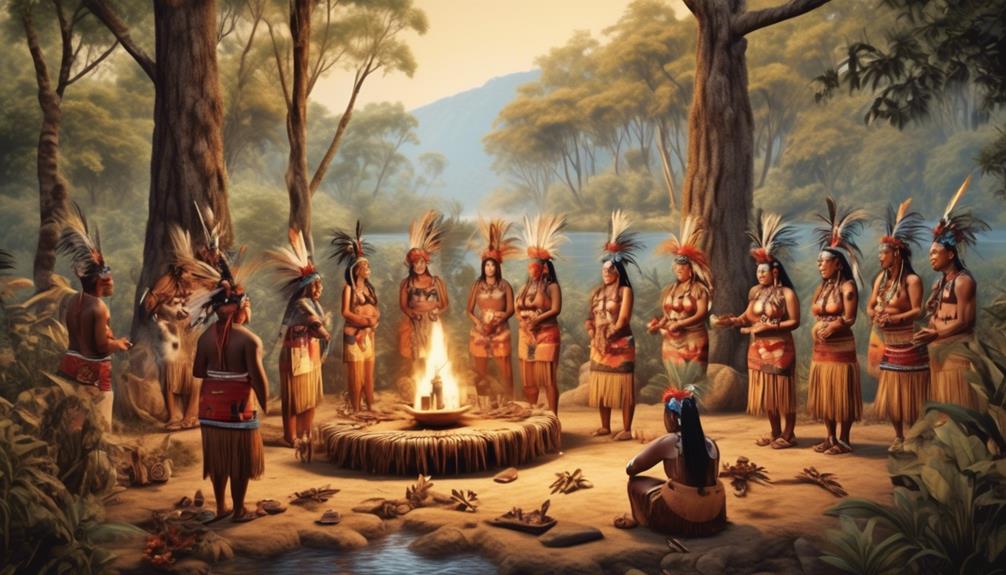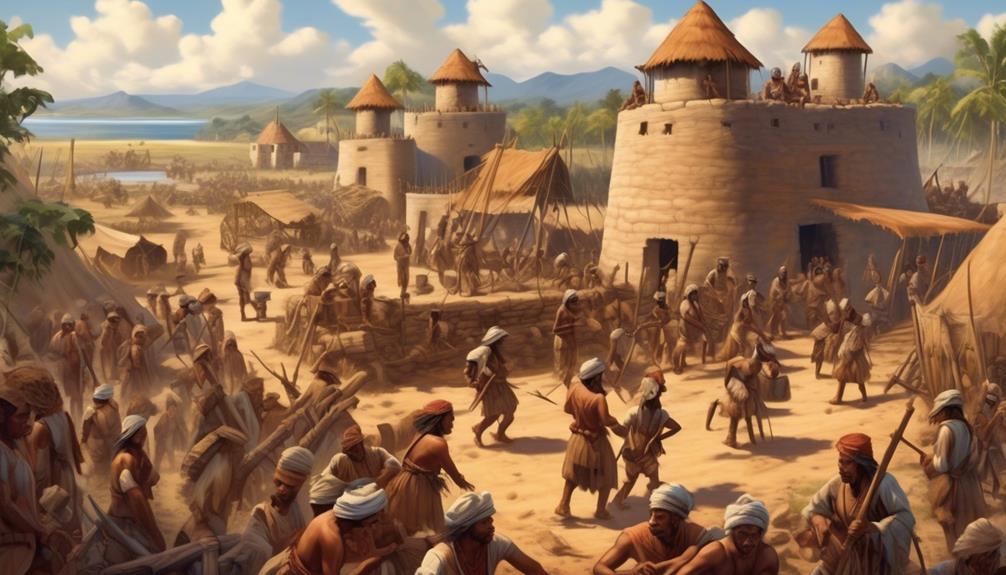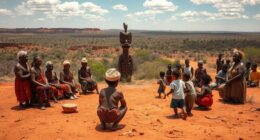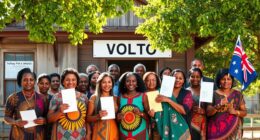As we near understanding the essential characteristics of indigenous religions, we step into a domain where the link between the natural and spiritual worlds is as intricate as vines in a thick forest.
The rich tapestry of these ancient belief systems is woven with threads of reverence for nature, passed down through generations in the form of oral traditions and storytelling.
But what sets indigenous religions apart is not just their connection to the earth, but also the communal and collective practices that bind their followers together in a sacred web of shared experiences.
These religions are steeped in animism and a sacred cosmology that permeates every aspect of life, giving rise to rituals and ceremonies that offer a glimpse into a worldview that is both mystical and profoundly rooted in the rhythms of the natural world.
Key Takeaways
- Indigenous religions have a deep spiritual connection to nature and prioritize a harmonious coexistence with the natural world.
- Oral tradition and storytelling play a central role in conveying indigenous religious beliefs, preserving cultural identity, and instilling respect for the environment.
- Communal and collective practices strengthen bonds within indigenous religious communities and contribute to spiritual fulfillment and social cohesion.
- Animism and sacred cosmology are central features of indigenous religions, emphasizing the belief in a spiritual essence in all natural entities and the interconnectedness of the living, deceased, and natural world.
Spiritual Connection to Nature
Indigenous religions often express a deep spiritual connection to nature, recognizing the interconnectedness of all living beings and the natural world. Nature worship is a fundamental aspect of many indigenous belief systems, where natural elements such as animals, plants, and landscapes are revered as sacred and divine. This reverence stems from a profound understanding of ecological spirituality, viewing the Earth as a living, breathing entity with which humans share a symbiotic relationship.
In contrast to some mainstream religions, indigenous belief systems often prioritize a harmonious coexistence with nature rather than dominance over it. This perspective fosters a deep sense of responsibility towards the environment, promoting sustainable practices and a deep respect for the Earth's resources. By acknowledging the intrinsic value of the natural world, indigenous religions offer a unique lens through which to perceive ecological issues and solutions.
Comparatively, the ecological spirituality found in indigenous religions stands in contrast to the anthropocentric views prevalent in many modern societies. This alternative perspective offers valuable insights into humanity's relationship with the environment, providing a holistic approach to addressing contemporary ecological challenges.
Oral Tradition and Storytelling

Drawing upon generations of wisdom and cultural heritage, oral tradition and storytelling play a central role in conveying the beliefs and values of indigenous religions. Oral tradition, an integral part of indigenous cultures, serves as a means of passing down sacred knowledge, historical accounts, and moral teachings from one generation to the next. Through storytelling, indigenous communities preserve their cultural identity and ensure the continuity of their religious practices. The oral transmission of religious narratives, myths, and rituals not only reinforces the spiritual beliefs of the community but also fosters a sense of interconnectedness with the past, present, and future.
In the realm of indigenous religions, oral tradition serves as a repository of cultural preservation, embodying the collective experiences and wisdom of the community. Furthermore, storytelling plays a crucial role in reinforcing the moral and ethical values upheld by indigenous belief systems. By weaving together intricate narratives that are often intertwined with the natural world and ancestral spirits, storytelling becomes a powerful tool for instilling a deep understanding of the interconnectedness between humans, nature, and the divine.
This oral tradition not only imparts religious teachings but also instills a profound respect for the environment and a harmonious way of life.
Communal and Collective Practices
Engaging in communal and collective practices strengthens the bonds within indigenous religious communities, fostering a shared sense of spirituality and interconnectedness. Community gatherings play a vital role in indigenous religions, providing a platform for members to come together, reaffirm their beliefs, and engage in traditional rituals. These gatherings often involve a blend of spiritual, cultural, and social elements, creating a cohesive environment where individuals can express their devotion and reinforce their connection to the community. Through these shared experiences, a collective identity is nurtured, and a deep sense of belonging is cultivated.
| Benefits | Description |
|---|---|
| Strengthening Bonds | Community gatherings and rituals serve as opportunities for individuals to connect with one another, reinforcing the communal ties that are integral to indigenous religious practices. |
| Preservation of Traditions | Traditional rituals, performed collectively, aid in the preservation and transmission of cultural and religious traditions from one generation to the next. |
| Spiritual Fulfillment | Participating in communal practices fosters a sense of spiritual fulfillment and unity, as individuals come together to honor their shared beliefs. |
| Social Cohesion | These collective practices contribute to the overall social cohesion within indigenous religious communities, promoting a sense of solidarity and mutual support. |
Animism and Sacred Cosmology
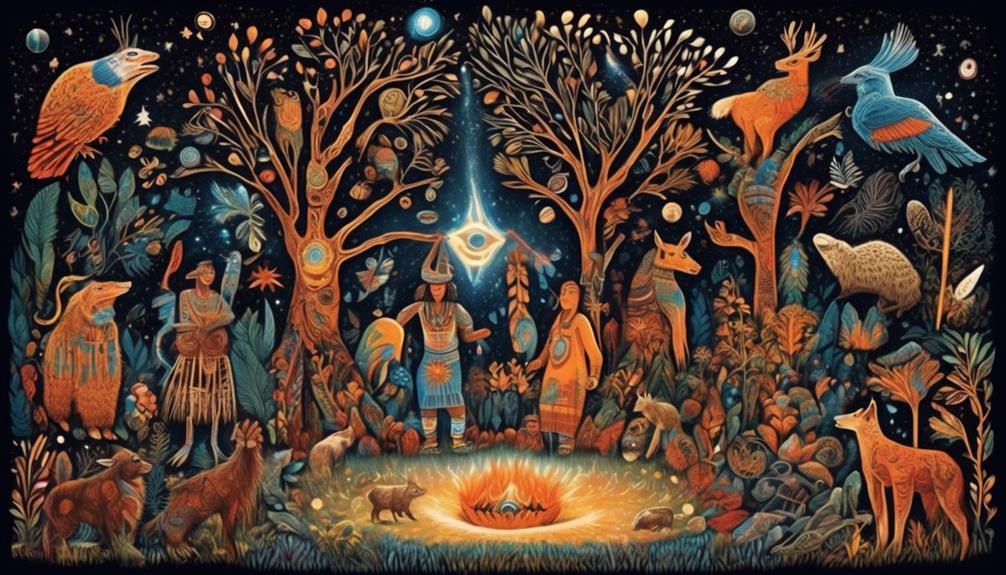
In the exploration of indigenous religious practices, understanding the concept of animism and its relationship to sacred cosmology provides valuable insights into the spiritual beliefs and interconnectedness with the natural world.
Animism, a central feature of many indigenous religions, is the belief that all natural entities, including animals, plants, and even inanimate objects, possess a spiritual essence. This worldview fosters a deep reverence for the environment and an understanding of the interconnectedness of all living beings.
Sacred cosmology, on the other hand, encompasses the belief in a structured and meaningful universe, often involving the division of the cosmos into different realms or layers, each with its own spiritual significance.
Ancestral worship is a common practice within indigenous religions that's closely tied to animism and sacred cosmology. It involves honoring and venerating the spirits of deceased ancestors, acknowledging their ongoing presence and influence in the lives of the living. This practice reinforces the interconnectedness between the living, the deceased, and the natural world, fostering a profound sense of continuity and harmony within the indigenous community.
Through animism and sacred cosmology, indigenous religions offer a unique perspective on the spiritual significance of the natural world and the interconnectedness of all life.
Rituals and Ceremonies
Rituals and ceremonies play a pivotal role in the expression of indigenous religious beliefs and communal identity. They serve as profound and symbolic acts that bind individuals and communities to their spiritual traditions. These practices often involve a range of symbolic gestures and the use of sacred objects that hold deep spiritual significance.
The creation of sacred space is fundamental to many indigenous rituals. Specific locations are designated as areas for connecting with the divine and ancestors. Additionally, ceremonial attire is often worn during these rituals, symbolizing the individual's acknowledgment of their role within the community and their connection to the spiritual realm.
When comparing indigenous rituals and ceremonies across different cultures, it becomes evident that while the specific practices and ceremonial objects may vary, the underlying purpose remains consistent. The purpose is to honor the sacred, connect with the spiritual world, and strengthen communal bonds. This comparative analysis highlights the universal aspects of indigenous religious practices, emphasizing the importance of rituals and ceremonies in fostering a sense of belonging and preserving cultural identity.
Frequently Asked Questions
How Do Indigenous Religions View the Concept of Sin and Forgiveness?
We see indigenous religions emphasizing moral responsibility and spiritual healing rather than sin and forgiveness.
Redemption is often sought through cultural traditions and community support.
These religions prioritize maintaining harmony with nature and the community.
Concepts of wrongdoing are often addressed through rituals and ceremonies aimed at restoring balance and healing.
Understanding these perspectives enriches our understanding of diverse spiritual beliefs and practices.
What Role Do Gender and Sexuality Play in Indigenous Religious Practices?
Gender roles and sexual identity are integral to indigenous religious practices. In sacred ceremonies, these aspects are symbolically represented, reflecting a harmonious balance between masculine and feminine energies.
Ritual practices often emphasize the interconnectedness of gender and spirituality, celebrating the unique contributions of both men and women.
Through these ceremonies, the community honors and upholds traditional values, fostering a deep appreciation for the diversity of human experience within the context of spirituality.
How Do Indigenous Religions Address the Concept of an Afterlife?
In indigenous religions, the concept of reincarnation is often central, with the belief that spirits are reborn into new life forms after death. Ancestral spirits play a significant role, guiding and protecting the living.
These beliefs foster a deep connection to the natural world and the ancestors. The afterlife is viewed as a continuation of existence, where the spirits of the departed remain present and influential in the lives of the living.
What Is the Relationship Between Indigenous Religions and Modern Medicine or Technology?
We might think traditional healing in indigenous spirituality clashes with modern technology, but they can complement each other.
Indigenous healing practices often focus on holistic well-being, aligning with modern medicine's increasing recognition of mind-body connections.
Incorporating indigenous wisdom into medical advancements can offer a more comprehensive approach to healthcare.
How Do Indigenous Religions Approach the Idea of Religious Conversion or Acceptance of Other Belief Systems?
When it comes to religious tolerance, indigenous religions often approach the idea of religious conversion with a focus on preserving their traditional beliefs and practices.
The conversion process is usually not actively promoted, as indigenous communities prioritize the preservation of their own spiritual traditions.
However, there's often an openness to accepting aspects of other belief systems that align with their own values, fostering a respectful approach to religious diversity.
Conclusion
In conclusion, the key characteristics of indigenous religions are deeply rooted in a spiritual connection to nature, oral tradition and storytelling, communal practices, animism, and sacred cosmology. These elements weave together to form a rich tapestry of rituals and ceremonies that honor the interconnectedness of all living beings.
As we continue to study and appreciate indigenous religions, we gain a greater understanding of the diverse ways in which humans seek meaning and connection in the world.
